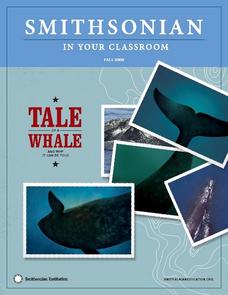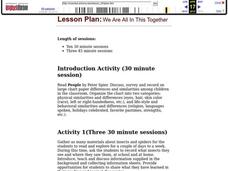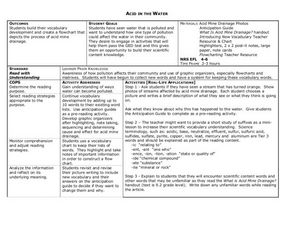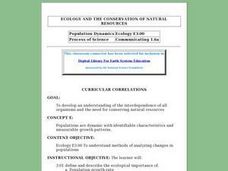Curated OER
Shoot for the Moon
Second graders distinguish the different phases of the moon. In this astronomy lesson, 2nd graders study the history of its discovery and myths about its origin. They simulate how the moon's surface is illuminated by the sun.
Curated OER
Draw an Alien in Natural Habitat
Students apply prior knowledge of living things, structures of living things and how living things sense and respond to their environment. In this habitat lesson, students review the basic needs of organisms to survive. Students create...
Curated OER
A Tale of a Whale: And Why It Can Be Told
Students examine the characteristics of particular whales. In this whale characteristics lesson, students discover the methods scientists use to track whales and attempt to match the unique pattern of callosities themselves. A role...
Curated OER
We Are All In This Together
Students complete a variety of activities centering around insects. In this insects education lesson, students read People by Peter Spier and discuss the similarities and differences among people. Students gather and explore materials...
Pennsylvania Department of Education
Animal Classes and Their Ecosystems
Students explore animal characteristics by participating in an environment identification activity. In this animal habitat lesson, students discuss a range of different wild life and the ecosystems that they are a part of. Students view...
Curated OER
Physics of Sound: How We Hear Sounds
Second graders identify the different function and parts of the ear. In this physics lesson, 2nd graders explain how we hear sound. They read about the life of Helen Keller and respond to questions that follow.
Curated OER
Weave an Aquatic Food Web
Students explore organisms that are part of interconnected food webs. In this food web lesson, students choose an animal and research what the animal eats. Students begin with the food chain and branch out into the interconnected web...
Curated OER
Rain On
Fourth graders explore evaporation and condensation. In this water cycle lesson, 4th graders investigate their surroundings for real-life examples of evaporation and condensation. Students conduct various experiments.
Curated OER
New Zealand Subduction Zone Model
Students explore world geography by creating a model in class. In this tectonic plate lesson, students identify diagrams which discuss the tectonic plates in New Zealand and how they affect everyday life. Students utilize cardboard,...
Curated OER
The Missing Piece: A Tale of a Tail
Students analyze and write about their findings of the dinosaur discoveries of Edward Cope. In this Edward Cope lesson plan, students examine illustrations of concept maps, discuss challenges, analyze skeleton diagrams, and write...
Curated OER
Which Part of the Great Salt Lake Stinks More?
Students research background knowledge of the Great Salt Lake prior to a field trip. They identify specific wild life at the Great Salt Lake on the field trip and identify the islands in the Great Salt Lake. They present their...
Curated OER
The Water Cycle
Fourth graders explore changes in water forms. In this water cycle lesson, 4th graders build a water cycle model and monitor it for 2 weeks in order to understand that water changes state as it moves through the cycle.
Curated OER
Where in the World? Biomes of the Earth
Learners research a biome. In this biomes of the Earth lesson, students discuss what they already know about ecology and view pictures of different biomes. Learners work in groups to research a different biome. Students use the...
Curated OER
Seed Surprises
Students investigate seeds and their growth. In this agriculture instructional activity, students read the book How a Seed Grows and discuss the seed cycle. Students examine real seeds and identify their properties. Students create a set...
Curated OER
A Growing Success
Students create a multimedia presentation as a culmination of a plant unit. In this hyperstudio lesson, students research from assigned sites and create a Hyperstudio stack. Students write a cinquain.
Curated OER
Acid in the Water
Ninth graders learn about the effect pollution has on water and how this affects their community. In this environmental awareness lesson, 9th graders expand their vocabulary and create a flowchart that demonstrates the process of acid...
Curated OER
Grandpa's Social Security
Young scholars examine social security and how the process works at different ages.In this retirement lesson students determine how long a retired person has to live to get the same benefits at different ages.
Curated OER
Life in a Cup
Third graders make and maintain a mini terrarium. They keep a daily journal of what happens in their terrarium and record daily observations and measurements.
Curated OER
Elements and Compounds
Students explain how radioactive decay occurs. In this physical science lesson plan, students simulate radioactive half-life through an experiment. They graph their data and share their results in class.
Curated OER
Become an Expert
Students practice their researching techniques by preparing a presentation with little notice. In this information research lesson, students utilize the Internet to research one of several subtopics concerning panthers. Students...
Curated OER
Population Dynamics (Lesson 2)
Middle schoolers discuss the importance of population growth rates. They examine mortality and survival curves and participate in an experiment. They record their observations and discuss.
Curated OER
Tree I.D.
Students explore various tree species. In this tree species instructional activity, students collect leaves on nature walks and use Internet sources to identify the trees that the leaves belong to. Students graph their data as well.
Curated OER
Chewin' in the Chesapeake
High schoolers examine a web page on food webs and select a habitat to research. In this research lesson students identify the organisms found in the food web and present their findings to the class.
Curated OER
Worm Weather Predicted
Students examine worm habitats. In this animal habitats lesson, students participate in a lab activity that requires them to explore the adaptations that earthworms make to their environment.

























